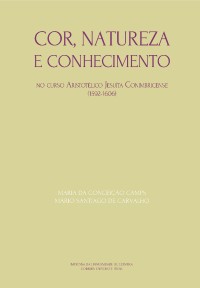Please use this identifier to cite or link to this item:
https://hdl.handle.net/10316.2/38833| DC Field | Value | Language |
|---|---|---|
| dc.contributor.author | Camps, Maria da Conceição | por |
| dc.contributor.author | Carvalho, Mário Santiago de | por |
| dc.date.accessioned | 2016-03-30T10:19:41Z | |
| dc.date.accessioned | 2020-03-15T00:49:08Z | - |
| dc.date.available | 2016-03-30T10:19:41Z | |
| dc.date.available | 2020-03-15T00:49:08Z | - |
| dc.date.issued | 2016 | - |
| dc.identifier.isbn | 978-989-26-1106-8 | por |
| dc.identifier.isbn | 978-989-26-1107-5 (PDF) | por |
| dc.identifier.uri | https://hdl.handle.net/10316.2/38833 | por |
| dc.description.abstract | Unified by the theoretical and hermeneutical arch that links physics to metaphysics, the three subjects here analysed, belonging to the famous Commentarii Collegii Conimbricensis Socíetatis lesu (1592-1606) - colour, nature and knowledge - strike the reader by their modernity. The first, reveals Coimbra productivity, regarding Manuel de Góis' theory of colours, so similar to Goethe's; the second, underlines ali the aesthetical possibilities the Coimbra Commentaries may confer to some theoretical domains as anthropology, cosmology or even science; lastly, after studying a theological theme that pertains to the doctrine of the knowledge, "separation", to the reader is proposed a surprisingly interpretation: the Cartesian tone ofthis precise theme. | eng |
| dc.description.abstract | Unificados pelo arco teórico e hermenêutico que liga a física à metafísica, os três temas dos célebres Comentários do Colégio Conimbricense da Companhia de Jesus (1592-1606) - cor, natureza e conhecimento - revelam a surpresa da sua modernidade filosófica: sobre o primeiro tema,' evidenciando a insuspeitada ... produtividade da teoria conimbricense, haja em vista a semelhança entre as doutrinas de Manuel de Góis e as de Goethe, a respeito das cores; sobre o segundo tema, estudando as várias aceções de "natureza" e, por isso, promovendo a valorização de uma preponderância estética nos domínios da antropologia, da cosmologia e até da ciência; finalmente, sobre o último tema, demonstrando a inesperada surpresa de uma problemática teológica, a separação do conhecimento, poder comparecer devidamente adaptada na revolução de Descartes. | por |
| dc.language.iso | por | por |
| dc.publisher | Imprensa da Universidade de Coimbra | por |
| dc.relation.ispartof | Ideia | por |
| dc.rights | open access | por |
| dc.subject | Coimbra Course | eng |
| dc.subject | Aristotelianism | eng |
| dc.subject | 16th Century | eng |
| dc.subject | Philosophy | eng |
| dc.subject | Colour | eng |
| dc.subject | Nature | eng |
| dc.subject | Knowledge | eng |
| dc.subject | Anthropology | eng |
| dc.subject | Conimbricenses | por |
| dc.subject | Aristotelismo | por |
| dc.subject | Filosofia | por |
| dc.subject | Século XVI | por |
| dc.subject | Cor | por |
| dc.subject | Natureza | por |
| dc.subject | Conhecimento | por |
| dc.subject | Antropologia | por |
| dc.title | Cor, natureza e conhecimento: no curso aristotélico jesuíta conimbricense (1592-1606) | por |
| dc.title.alternative | Colour, natura and knowledge in the Aristotelian Coimbra Jesuit Course (1592-1606) | eng |
| dc.type | book | por |
| uc.publication.location | Coimbra | por |
| dc.identifier.doi | 10.14195/978-989-26-1107-5 | por |
| uc.publication.digCollection | PB | por |
| uc.publication.area | Artes e Humanidades | por |
| uc.publication.manifest | https://dl.uc.pt/json/iiif/10316.2/38833/149338/manifest?manifest=/json/iiif/10316.2/38833/149338/manifest | - |
| uc.publication.thumbnail | https://dl.uc.pt/retrieve/8173276 | - |
| uc.itemId | 54600 | - |
| item.grantfulltext | open | - |
| item.fulltext | With Fulltext | - |
| Appears in Collections: | Pombalina | |
Files in This Item:
| File | Description | Size | Format | |
|---|---|---|---|---|
| cor_natureza_e_conhecimento.pdf | 2.76 MB | Adobe PDF |  |
Items in DSpace are protected by copyright, with all rights reserved, unless otherwise indicated.
